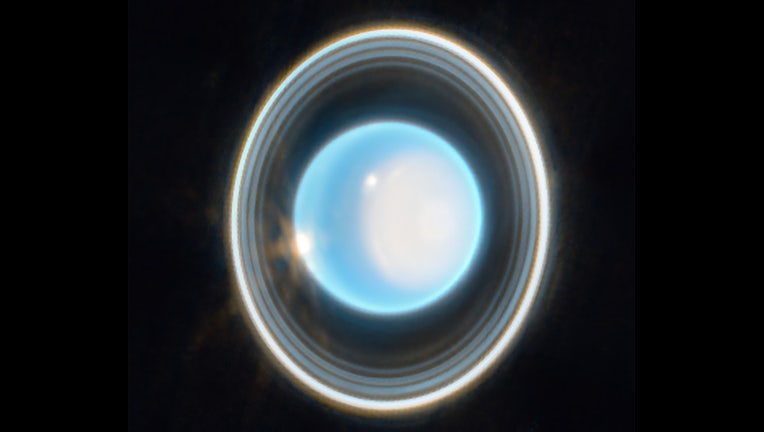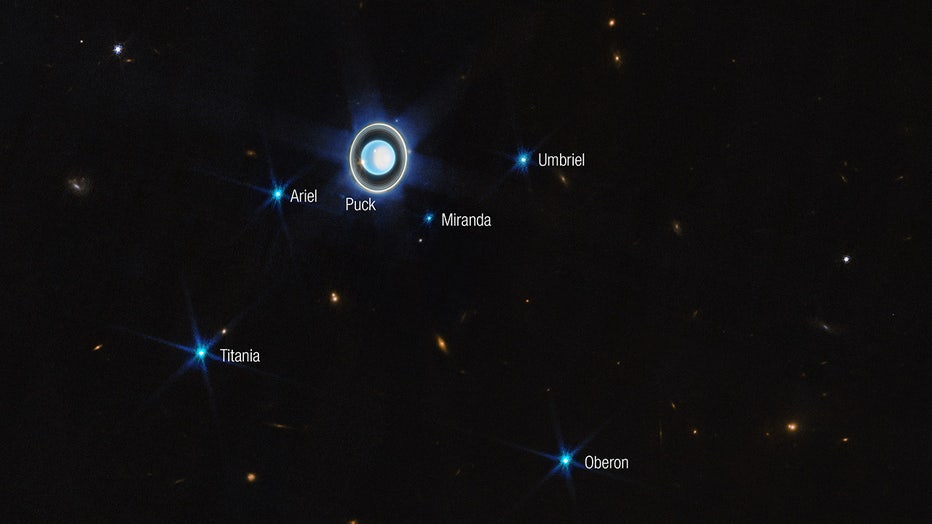Stunning image of Uranus and its rings captured by James Webb telescope

This zoomed-in image of Uranus, captured by Webb’s Near-Infrared Camera (NIRCam) Feb. 6, 2023, reveals stunning views of the planet’s rings. The planet displays a blue hue in this representative-color image, made by combining data from two filters (F (NASA, ESA, CSA, STScI. Image processing: J. DePasquale (STScI))
Once again, the James Webb Space Telescope has delivered a stunning image of one of the solar system’s ice giants: Uranus.
The new image, which was taken on Feb. 6, 2023, was released by NASA on Thursday and shows Uranus and its rings in amazing detail.
"The Webb data demonstrates the observatory’s unprecedented sensitivity for the faintest dusty rings, which have only ever been imaged by two other facilities: the Voyager 2 spacecraft as it flew past the planet in 1986, and the Keck Observatory with advanced adaptive optics," NASA said in a news release.
The image clearly displays Uranus’ northern pole, which is currently in its late spring season. The northern pole will not experience its summer season until the year 2028.
"In contrast, when Voyager 2 visited Uranus it was summer at the south pole. The south pole is now on the ‘dark side’ of the planet, out of view and facing the darkness of space," NASA said.
RELATED: NASA's James Webb Space Telescope finds 'turbulent skies' with clouds, water molecules on exoplanet
The bright spot on the right side of the planet which indicates where the northern pole is located is unique because it seems to only appear when it is in direct sunlight but once the fall season begins, it vanishes.
At the edge of the polar ice cap is what scientists at NASA said is a bright cloud and a second cloud can be seen at the left edge of the planet.
"Such clouds are typical for Uranus in infrared wavelengths, and likely are connected to storm activity," NASA said.
The James Webb telescope managed to capture 11 of Uranus’ 13 rings though in the image, some of the rings appear so brightly, they tend to look merged together.
The space telescope also captured several of Uranus’ 27 moons including Umbriel, Ariel, Puck, Miranda, Titania, and Oberon.

This wider view of the Uranian system with Webb’s NIRCam instrument features the planet Uranus as well as six of its 27 known moons (most of which are too small and faint to be seen in this short exposure). A handful of background objects, including (NASA, ESA, CSA, STScI IMAGE PROCESSING: Joseph DePasquale (STScI))
About Uranus
Uranus was discovered in 1781 by astronomer William Herschel who originally wanted to name the planet Georgium Sidus, after King George III, according to NASA.
The seventh planet from the sun is unique because it rotates on its side at about a 90-degree angle.
This angle causes extreme seasons on Uranus since the planet’s poles experience several years of constant sunlight and an equal amount of years in constant darkness.
It takes Uranus about 84 Earth years to orbit the sun and takes about 17 hours to make a full rotation.
Uranus is known as an ice giant because of its chemical makeup.
"Most of its mass is thought to be a hot, dense fluid of ‘icy’ materials – water, methane, and ammonia – above a small rocky core," according to NASA.
Of Uranus’ 13 rings, nine are considered the main rings and two are the fainter dusty rings which weren’t discovered until the 1986 flyby by Voyager 2.
The rings have been categorized into two sets and most have either been numbered or named.
They are called Zeta, 6, 5, 4, Alpha, Beta, Eta, Gamma, Delta, Lambda, Epsilon, Nu, and Mu.
This story was reported from Los Angeles.

